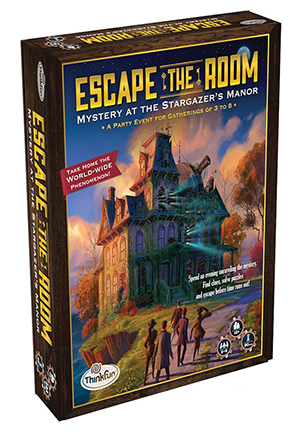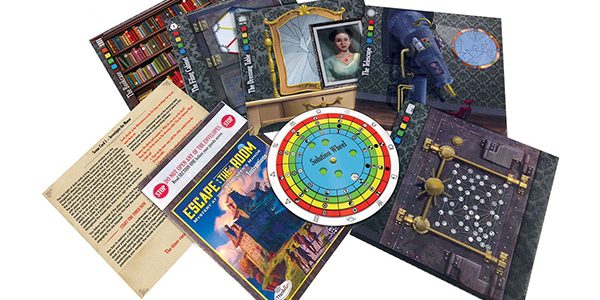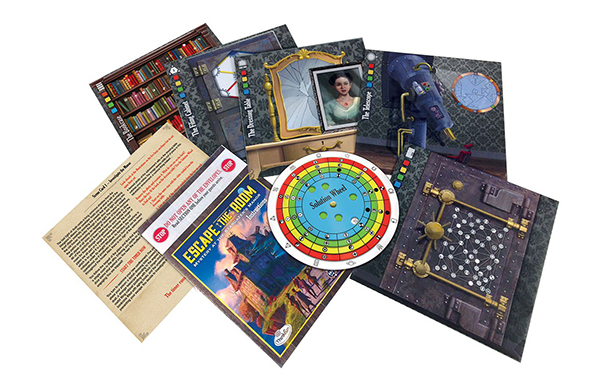 For years now, board gaming has been in the midst of a renaissance. New and inventive designs with unique play mechanics and beautiful artwork are at the forefront of the hobby, so it came as no surprise when I learned of a game based on the many live room escape attractions (which, in turn, were based on point-and-click puzzle/adventure video games) that have been popping up in cities across the country. Escape the Room: Mystery at the Stargazer’s Manor is an interesting concept from ThinkFun that almost translates the room escape experience — being trapped inside a room, forced to unlock a combination of puzzles in order to earn your freedom — to the tabletop, but falls short in a few key areas.
For years now, board gaming has been in the midst of a renaissance. New and inventive designs with unique play mechanics and beautiful artwork are at the forefront of the hobby, so it came as no surprise when I learned of a game based on the many live room escape attractions (which, in turn, were based on point-and-click puzzle/adventure video games) that have been popping up in cities across the country. Escape the Room: Mystery at the Stargazer’s Manor is an interesting concept from ThinkFun that almost translates the room escape experience — being trapped inside a room, forced to unlock a combination of puzzles in order to earn your freedom — to the tabletop, but falls short in a few key areas.
The primary faults with Escape the Room: Mystery at the Stargazer’s Manor lie in the player count and perhaps the age range designation on the box. While the game can be played with the listed 3-8 players 10 years old and older, I can’t recommend this game for a player count of any more than four players. I would also suggest that at least one player actually be a child to be able to fully appreciate the experience. In fact, judging from my one-time play-through with six adults, I would estimate that the optimal age range for this game is something like 8-15 years old. Or perhaps it should just be a single-player game. It’s a simple set of puzzles presented as a linear progression through a light narrative, and as such doesn’t scale well when the brain power processing those puzzles is multiplied.
 That’s not to say that Mystery at the Stargazer’s Manor isn’t enjoyable. The unknown element of the game’s five primary sealed envelopes (some with additional envelopes nested inside) and the sense of discovery when opening each subsequent one arouses a sort of thrill that’s hard to achieve in the tabletop game space. The only problem is that because of the game’s lack of challenge, that feeling doesn’t originate from a sense of accomplishment, but simply from the fact that you’re suddenly allowed to look at new game components that you were previously forbidden to see. It can feel like just going through the motions that the game lays out for you, punctuated by a little goodie-bag reveal here and there.
That’s not to say that Mystery at the Stargazer’s Manor isn’t enjoyable. The unknown element of the game’s five primary sealed envelopes (some with additional envelopes nested inside) and the sense of discovery when opening each subsequent one arouses a sort of thrill that’s hard to achieve in the tabletop game space. The only problem is that because of the game’s lack of challenge, that feeling doesn’t originate from a sense of accomplishment, but simply from the fact that you’re suddenly allowed to look at new game components that you were previously forbidden to see. It can feel like just going through the motions that the game lays out for you, punctuated by a little goodie-bag reveal here and there.
Chatting with the other people around the table, reading the new bits of narrative in funny voices, and seeing how everyone engages with the puzzles and with each other were the high points of my play session with Escape the Room: Mystery at the Stargazer’s Manor. This social aspect of playing together as a group of friends is what made the game worthwhile. Of course, this statement is at odds with my earlier suggestion to play solo, but that undertaking would be for the purpose of optimizing the game’s puzzle aspects, which doesn’t really have any bearing on its value as a social experience.
I’ve avoided describing the game in much detail up to this point because a) one can only speak in generalities about the puzzles, which are mostly visual-spatial tasks, in order to avoid spoiling anything — the surprise of it all is a major part of the fun — and b) the above information is truly my greatest takeaway from my experience playing the game.
But as far as how Escape the Room: Mystery at the Stargazer’s Manor actually plays out, it can be summed up quite simply. Players read a few paragraphs of text that introduces the plot and tells them where to begin, then use the first clue to learn how to operate the game’s puzzle wheel, which is how players check their solutions for every single puzzle in the game. The first solution grants access to the first of five large envelopes, each of which remains sealed until “unlocked” in this manner, at which point players dump everything out, read the next part of the story, and use the envelope’s contents and narrative clues to work on the next puzzle. After the last puzzle, the players win the game.
I would have loved to see more of an open-ended, sandbox-style approach to Escape the Room: Mystery at the Stargazer’s Manor. The best live and videogame escape rooms generally tend to have a few puzzle paths that overlap, leaving various options open at a time and leaving it up to the participants to determine what to work on at any given moment in order to find the next puzzle-solving opportunity. Here, you just do the puzzles in order, as they are made accessible.
That said, I think this is a great game for families with children in the pre-teen range; kids and their parents should have a great time with this in groups of four or less, and I’m rating the game with that scenario in mind. ThinkFun would be doing potential customers a service to clearly market it as a family game, though. As it’s presented now, as “a party event for gatherings of 3 to 8” with suggestions for preparing the game for your guests, it suggests a more adult-appropriate experience, and doesn’t live up to the expectations that come along with that concept.



















